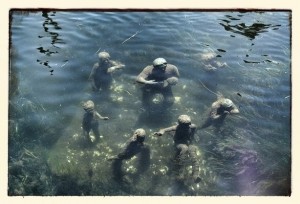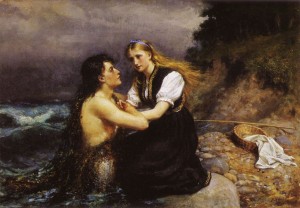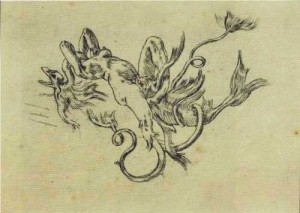Tales of men and mermaids tend to concentrate on the mermaid joining her human partner in his terrestrial life. Things appear to be different for women and mermen. There is an impressive and ancient literature of northern Europe that deals with this theme. One persistent story involves a maiden who marries a merman, bears his children then deserts him. There is an underwater sculpture in Copenhagen (more famous for the Little Mermaid statue) that commemorates the tale of Agnete and the Merman.
This story appears to stem from German or Slavonic tradition (Wright 1918 p91) although it is best known from Hans Christian Andersen’s 1833 poem and the dramatic work based on it in 1842. The English writer George Borrow wrote an influential poem based on the merman legend which appears to have been the model for the more renowned effort by Matthew Arnold, ‘The Forsaken Merman’.
Kierkegaard discussed the Agnete legend at length. He resented what he saw as Andersen’s trivialisation of an astonishing tale of philosophy and religion. He concluding that the merman does not so much seduce the maiden as elicit her hidden desire for ‘the interesting’. (Jacobsen and Leavy 1988 p128-129). She has been searching in the seas for something to fulfil her desire. When the merman comes to take her she, in her innocence, accepts what he offers. Kierkegaard spends much time analysing the motivations of the merman but here we are interested in what would entice an innocent woman to put herself in the power of a predatory merman.
Kierkegaard’s alternative reading of the Agnete legend acknowledges the lust that she may feel for the wild, unpredictable aspects of the sea. ‘She wants to be off and away, to storm wildly out into the infinite with the merman…’ (Kierkegaard 1843, pp 95) He goes on to postulate that at the expense of ethics, ‘esthetics throws the cloak of love over the merman…’ (Kierkegaard 1843, pp 97)
This is an admirable explanation of what happens as a woman prepares to have sex with a fish. The intensity of the dream of escape into an exciting alternative world cloaks the slimy reality of the fish being employed for the purpose. The incomparable Felicien Rops represented this apparent metamorphosis in his engraving ‘Transformism’.
The woman, already losing her terrestrial identity to the pounding rhythm of the sea is pleasured by a deeply engrossed fish. Her rapture, presumably at the onset of orgasm, transforms a part of her into another symbol of fertility, the soaring bird. The orgasm, le petit mort, means that a part of her essence escapes each time she couples with the fish/merman. This keeps her in the power of the fish and enables him to demand a repeat performance.
There is no such thing as a merman, any more than there is the mermaid of parallel male fantasy. However, the almost universal appearance of the merman in legend indicates that women all over the world have been engaging in sexual activity with fish throughout recorded history. The suspended disbelief of fantasy and desire creates the compelling image of the merman, sufficiently human in the mind of the romantic idealist to carry her through the barrier of inhibitions that normally exert a powerful deterrent effect on such behaviour.
References
Jacobsen, Per Schelde and Leavy, Barbara Fass (1988): Ibsen’s Forsaken Merman: Folklore in the Late Plays. New York University Press.
Kierkegaard, Soren: Fear and Trembling. 1843. Penguin Classics edition, Harmondsworth, Middlesex. 1986.
Wright, Herbert (1918): The Source of Matthew Arnold’s ‘Forsaken Merman’. The Modern language Review Vol 13, No 1. (Jan 1918) pp 90-94
 [4]
[4]


